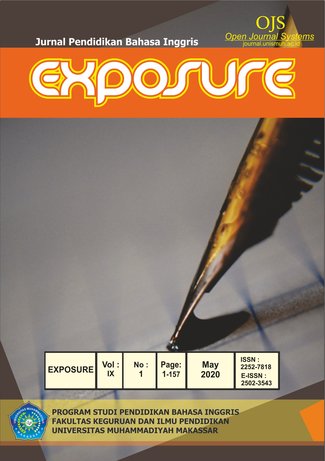ESL LEARNERS’ PERCEPTION ON THE USE OF THE GRAPHIC ORGANIZERS (GOs) AS CLASS PRESENTATION STRATEGIES
DOI:
https://doi.org/10.26618/exposure.v9i1.3494Keywords:
English Language Teaching (ELT), Graphic Organizers (GOs), Presentation StrategiesAbstract
The study scientifically, empirically, and objectively conducted aims at knowing the ESL learners’ perceptions towards the practices of graphic organizers conveniently used as presentation media or strategies in high class activities (a class-presentation task). In order to achieve the aim of the study, the researcher used a quantitative research technique along with its instrument, a questionnaire. The data was collected through applying a questionnaire, and then analyzed in a descriptive statistic method. The results suggest that the perceptions of low English speakers in using graphic organizers as presentation strategies was moderate (M=3.7). Meanwhile, ESL learners owning a good English proficiency perceived the use of graphic organizers as presentation strategies positively (M=4.5). All in all, the use of Graphic Organizers (GOs) as ESL learners’ presentation media or strategies was perceived favorably.
References
Alvermann, D.E. (1981). The Compensatory Effect of Graphic Organizers on Text Structure. ERIC Document Reproduction Service. ED. 208019.
Akbar, F. (2014). The Role of Reading in Improving Speaking Skills in the Context if Teaching English as a Foreign Language. International Journal of English Language and Translation Studies. 2 (4), 92-98.
Cheng, K.E., Sung, Y.T., & Chen, I.D. (2002). The Effect of Concept Mapping to Enhance Text Comprehension and Summarization. Journal of Experimental Education. 71, 5-23.
Davoudi, M. & Yousefi, D. (2016). The Effect of Graphic Organizer Instruction on Reading Comprehension Improvement of EFL Learners in Iran. International Conference on Literature and Linguistics (irLIT). 1-14.
Fatimayin, F. (2017). Teacher’s Perception of Graphic Organizers as Effective Strategy for Teaching Reading Comprehension Skills. Faculty of Education, National Open University of Nigeria.
Kansizoglu, H.B. (2017). The Effect of Graphic Organizers on Language Teaching and Learning Areas: Meta-Analysis Study Education and Science. 42 (191), 139-164.
Lawal, A. & Adebileje, A.O. (2005). Visual Literacy and the Use of Advanced Organizer in Reading Comprehension Lessons. In A. Dadu, A. Abimbade and O.O. Kolawole (eds). Issues in Language, Communication and Education. A Book of Reading in honor of Carline A. Okedara. Ibadan: Counstellations Books.
Manoli, P. & Papadoulou, M. (2012). Graphic Organizer as a Reading Strategy: Research Findings and Issues. Creative Education. 3 (3), 348-356.
Mart, C.T. (2012). Developing Speaking Skills Through Reading. International Journal of English Linguistics. 2 (6), 91-96.
Praveen, S.D. & Premalatha, R. (2013). Using Graphic Organizers to Improve Reading Comprehension Skills for Middle School ESL Students. English Language Teaching. 6 (2), 155-170.
Rahim, P.R.M.A., Yusuf, F. & Dzulkafli, Z. (2017). Facilitating Reading Comprehension among ESL Learners Using Graphic Organizers. Malaysian Journal of ESL Research. 13 (1), 30-42.
Varghese, J.L. (2015). Relationship between Oral Language and Reading Comprehension for English Learners: A Systematic Review. School of Education Student Captone Thesis and Dissertations. 132.https://digitalcommons.hamline.edu/hse all/132. 1-91.
Downloads
Published
Issue
Section
License
Authors who publish with this journal agree to the following terms:
In order to assure the highest standards for published articles, a peer review policy is applied. In pursue of the compliance with academic standards, all parties involved in the publishing process (the authors, the editors and the editorial board and the reviewers) agree to meet the responsibilities stated below in accordance to the Journal publication ethics and malpractice statement.
Duties of Authors:
- The author(s) warrant that the submitted article is an original work, which has not been previously published, and that they have obtained an agreement from any co-author(s) prior to the manuscript’s submission;
- The author(s) should not submit articles describing essentially the same research to more than one journal;
- The authors(s) make certain that the manuscript meets the terms of the Manuscript Submission Guideline regarding appropriate academic citation and that no copyright infringement occurs;
- The authors(s) should inform the editors about any conflict of interests and report any errors they subsequently, discover in their manuscript.
Duties of Editors and the Editorial Board:
- The editors, together with the editorial board, are responsible for deciding upon the publication or rejection of the submitted manuscripts based only on their originality, significance, and relevance to the domains of the journal;
- The editors evaluate the manuscripts compliance with academic criteria, the domains of the journal and the guidelines;
- The editors must at all times respect the confidentiality of any information pertaining to the submitted manuscripts;
- The editors assign the review of each manuscript to two reviewers chosen according to their domains of expertise. The editors must take into account any conflict of interest reported by the authors and the reviewers.
- The editors must ensure that the comments and recommendations of the reviewers are sent to the author(s) in due time and that the manuscripts are returned to the editors, who take the final decision to publish them or not.
Authors are permitted and encouraged to post online a pre-publication manuscript (but not the Publisher’s final formatted PDF version of the Work) in institutional repositories or on their Websites prior to and during the submission process, as it can lead to productive exchanges, as well as earlier and greater citation of published work (see The Effect of Open Access). Any such posting made before acceptance and publication of the Work shall be updated upon publication to include a reference to the Publisher-assigned DOI (Digital Object Identifier) and a link to the online abstract for the final published Work in the Journal.

